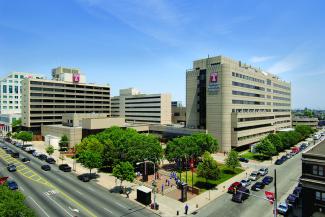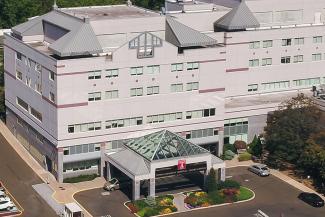The aorta is the body’s largest artery; it carries blood pumped from the heart to the rest of the body. The part of the aorta that connects to the heart is called the aortic root, and surrounds the aortic valve, which acts like a floodgate outlet for the heart. If the aorta is weakened or dilated near the root (aneurysm), the patient is at risk for rupture—a serious and potentially deadly occurrence. A weak aortic root can also hinder the function of the aortic valve, which may lead to heart problems. The coronary vessels, which supply the heart muscle itself, also come out of the aorta root.
Aortic Root Surgery
Conditions Treated
- Aortic Aneurysm
- Aortic Dissection
- Thoracoabdominal Aortic Aneurysm
Treatment Options
If the aortic root is weak or damaged, Temple surgeons may recommend a special procedure to replace the aorta root with a strong synthetic tube (a graft) sewn in to replace the weakened aorta. The coronary vessels (which supply the heart muscle itself) come out of the aorta root, and the new artificial graft needs to attach to the heart directly atop the aortic valve, so the procedure is quite complex.
If the aortic valve is damaged or contributing to aortic weakness, or if it would help ensure a good surgical outcome, surgeons may decide to replace the valve at the same time as they repair or replace the root. The new valve may be mechanical or biological—if mechanical, the patient will need to take an anticoagulant (blood thinner) drug afterwards to prevent clots.
If the aortic root needs to be replaced or repaired with a graft, but the valve and the very base of the root are in good shape, the patient may be a candidate for a valve-sparing procedure. This involves repairing or replacing the aortic root with a graft and attaching the aortic valve to the new graft; the surgeon may also reposition the valve within the graft to eliminate any leaking. A valve-sparing procedure could reduce the risk of stroke or infection and lessen the chance that the valve will need to be operated on again later. The patient may also avoid the lifelong course of anticoagulant therapy required with a mechanical valve.
For patients with more complex conditions, open surgical repair of the aorta may be combined with another procedure. For example, the patient might have surgery to repair an aneurysm near the aortic root while the surgeon also inserts an endovascular stent to strengthen the descending aorta, or other cardiac procedures. These hybrid procedures avoid multiple open surgeries and associated complications, and may be safer, shorter, and offer faster recovery.
If another heart problem contributes to the patient’s aortic condition, or vice versa, a Temple surgeon may recommend additional procedures or surgeries such as heart valve surgery, angioplasty, or insertion of a pacemaker or circulatory assist device. Some of these procedures can be done at the same time as the aortic root surgeries mentioned above. Others are done as a follow-up. Many can now be performed using minimally invasive techniques.
Why Temple?
Procedures to repair or replace the aortic root are highly specialized. Temple Heart & Vascular Institute has access to sophisticated facilities—including hybrid operating rooms with special imaging equipment for complex procedures—and an experienced team who can help determine appropriate treatment measures and provide the highest standard of care before, during and after surgery.
Ready for an Appointment?
Find a doctor near you, request an appointment, or call 800-TEMPLE-MED (800-836-7536) today.
Our Locations
The locations listed below are physician practices on Temple Health campuses. For a full list of providers, go to our Find a Doctor search.

